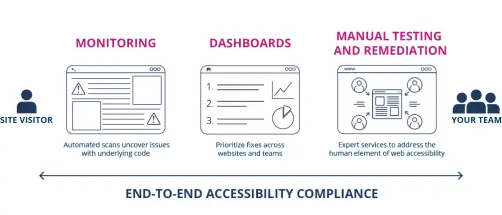WCAG 2.2 Compliance: What You Need to Know

With so many of us spending more time at home and on the web, it’s more critical than ever that web content is accessible to all users, including those with disabilities.
To help realize this goal, the World Wide Web Consortium (W3C) developed the Web Content Accessibility Guidelines (WCAG) - the global standard for digital accessibility. The W3C is continually working to evolve the guidelines, and in August 2023 released a Proposed Recommendation of the latest update: Web Content Accessibility Guidelines 2.2 (WCAG 2.2).
With a tentative release date this September 2022, WCAG 2.2 further improving accessibility guidance for users with cognitive or learning disabilities, users with low vision, and users with disabilities on mobile devices.
The WCAG are cited in accessibility regulations around the world, so any organization that considers inclusion to be an important aspect of doing business - or has websites subject to the Americans with Disabilities Act (ADA), European Accessibility Act (EAA), Accessibility for Ontarians with Disabilities Act (AODA), or other global regulation - will want to track these updates to ensure the compliance of all existing and future digital content.
To help organizations realize this standard, we share below —
- The new additions to the WCAG 2.2 guidelines
- WCAG 2.2 timeline for adoption
- Why companies should address the latest guidelines now to improve their business outcomes and avoid the risk of website accessibility lawsuits, which have become common
- The most complete and cost-effective approach to complying with the guidelines.
What’s new in WCAG 2.2.
The latest update of WCAG 2.2 has been designed to maintain backward compatibility with its predecessors, WCAG 2.0 and 2.1. The only notable difference is that WCAG 2.2 no longer includes 4.1.1 Parsing (Level A) as it is no longer relevant with the current technology.
It's important to note that WCAG 2.2 includes nine new success criteria, six of which are at Level A and AA. If your company is striving for Level AA compliance, this update should be carefully considered.
2.4.11 Focus Not Obscured (Minimum) (Level AA).
What to do
- Ensure when an item gets keyboard focus, it is at least partially visible.
Why it’s important
- People who can't use a mouse need to see what has keyboard focus.
2.4.12 Focus Not Obscured (Enhanced) (Level AAA).
What to do
- Ensure when an item gets keyboard focus, it is fully visible.
Why it’s important
- People who can't use a mouse need to see what has keyboard focus.
2.4.13 Focus Appearance (Level AAA).
What to do
- Use a focus indicator of sufficient size and contrast.
Why it’s important
- Many people, including older people, can't see small changes in visual appearance.
2.5.7 Dragging Movements (Level AA).
What to do
- For any action that involves dragging, provide a simple pointer alternative.
Why it’s important
- Some people cannot use a mouse to drag items.
2.5.8 Target Size (Minimum) (Level AA).
What to do
-
- Ensure targets meet a minimum size or have sufficient spacing around them.
Why it’s important
-
- Some people with physical impairments cannot click small buttons that are close together.
3.2.6 Consistent Help (Level A).
What to do
- Put help in the same place when it is on multiple pages.
Why it’s important
- People who need help can find it more easily if it's in the same place.
3.3.7 Redundant Entry (Level A).
What to do
- Don't ask for the same information twice in the same session.
Why it’s important
- Some people with cognitive disabilities have difficulty remembering what they entered before.
3.3.8 Accessible Authentication (Minimum) (Level AA).
What to do
- Don’t make people solve, recall, or transcribe something to log in.
Why it’s important
- Some people with cognitive disabilities cannot solve puzzles, memorize a username and password, or retype one-time passcodes.
3.3.9 Accessible Authentication (Enhanced) (Level AAA).
What to do
- Don’t make people recognize objects or user-supplied images and media to login.
Why it’s important
- Some people with cognitive disabilities can't do puzzles, including identifying objects and non-text information they previously supplied.
When will WCAG 2.2 be released?
A “Proposed Recommendation” has been provided in on July 20, 2023.
The WCAG 2.2 as a “W3C Recommendation” is expected to be publish by the end of 2023.
Why organizations should comply with WCAG 2.2 now
Digital accessibility is mandatory in many countries around the world:
- In the US: web accessibility regulation falls under the Americans with Disabilities Act (ADA) . Recent years have seen an explosive growth in the number of ADA-based digital accessibility lawsuits - in 2021 they reached 10 per day - a 15% increase from 2020. The financial risk is significant, with landmark lawsuits reaching over $6M.
- In the EU: private sector companies must prepare for the European Accessibility Act (EAA) , which is set to come into force in July 2025. The act calls for member states to enforce penalties for noncompliance in a way that is “effective, proportionate, and dissuasive.”
Aside from the potential legal ramifications of failing to provide an accessible website, companies miss out on the opportunity to capture market share ( approximately half a trillion dollars in purchasing power ). This is especially true in the age of COVID-19 aftermath, when more and more disabled individuals are relying on digital services to get the support they need.
As the pressures mount, it’s becoming critical for companies to align with the law or face significant risk and loss of business opportunity.
While WCAG 2.0 remains a W3C recommendation — and is currently the default standard cited in accessibility litigations — organizations should start considering the WCAG 2.2 changes and new success criteria now, both to future-proof their current accessibility efforts and to ensure better support for the needs of web and mobile users with disabilities.
Looking ahead: When will WCAG 3.0 be released?
In parallel with WCAG 2.2, the W3C’s is also working toward a major restructuring of the accessibility guidelines. named WCAG 3.0.
Set to shake up existing practice, the guidelines will be structured differently to the WCAG 2.X series and will not be backwards compatible. While it is important to keep track of developments, it is not recommended to start building WCAG 3.0 into your accessibility program until it is published as an official W3C recommendation.
Crownpeak DQM - the most complete and cost-effective approach to WCAG 2.2 compliance
Given the technical and resource challenges of staying up to date with the continually evolving WCAG guidelines, many organizations struggle to achieve even basic levels of compliance, hampering the success of their digital initiatives and putting their organizations at risk. According to the 2023 WebAIM Million Report on the accessibility of the top 1,000,000 home pages, 96.3% of the surveyed pages had WCAG 2 failures - and because automatic testing alone cannot detect all WCAG failure types, the actual level of conformance is presumed to be even lower.
At Crownpeak, we're passionate advocates for web accessibility and believe in helping our customers achieve an inclusive and exceptionally good user experience for all.
Our Digital Accessibility brings together the power of automated technology with expert testing and remediation, to help companies deliver fully-inclusive, WCAG, ADA and EAA compliant digital experiences with speed and efficiency.
